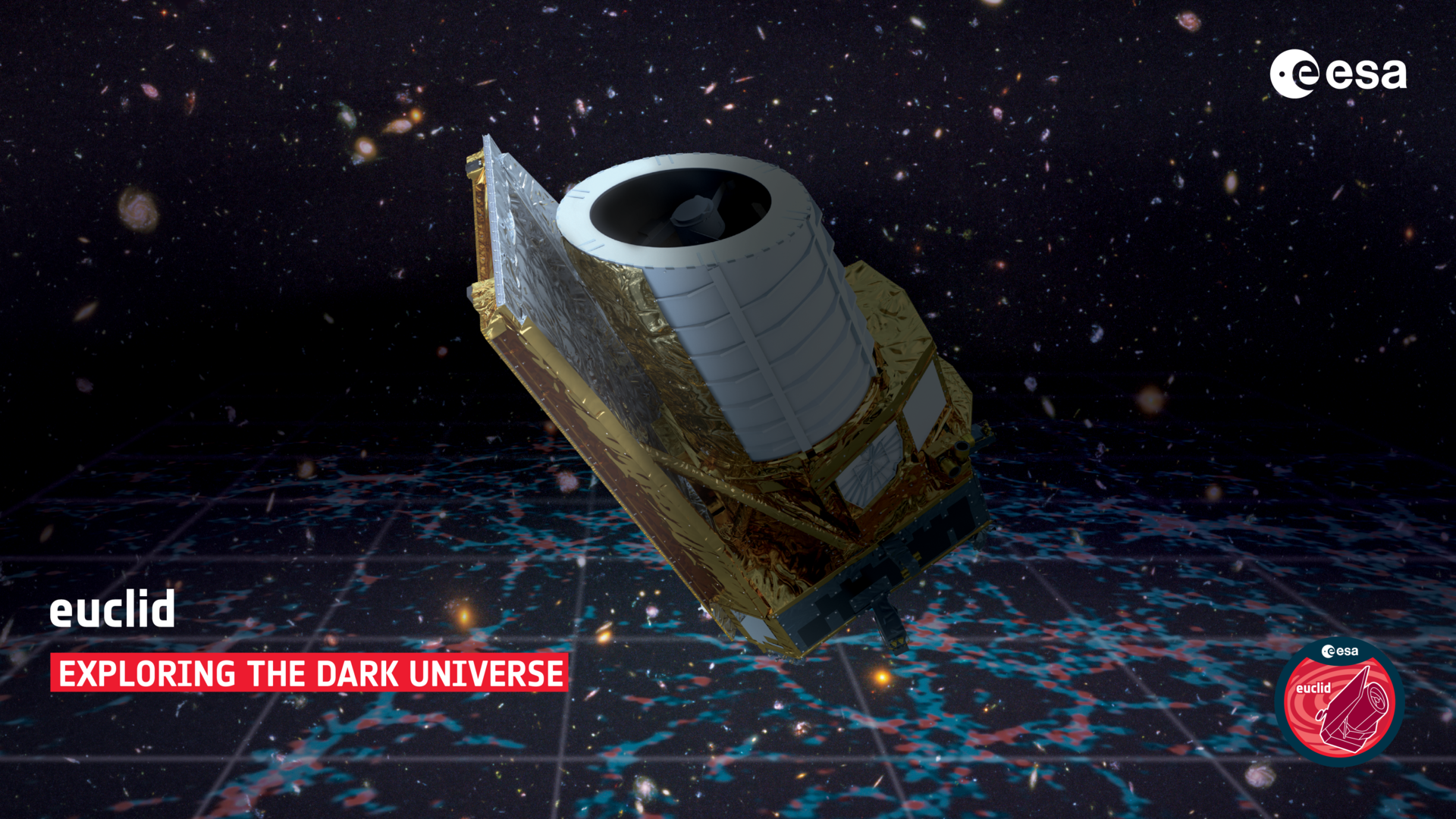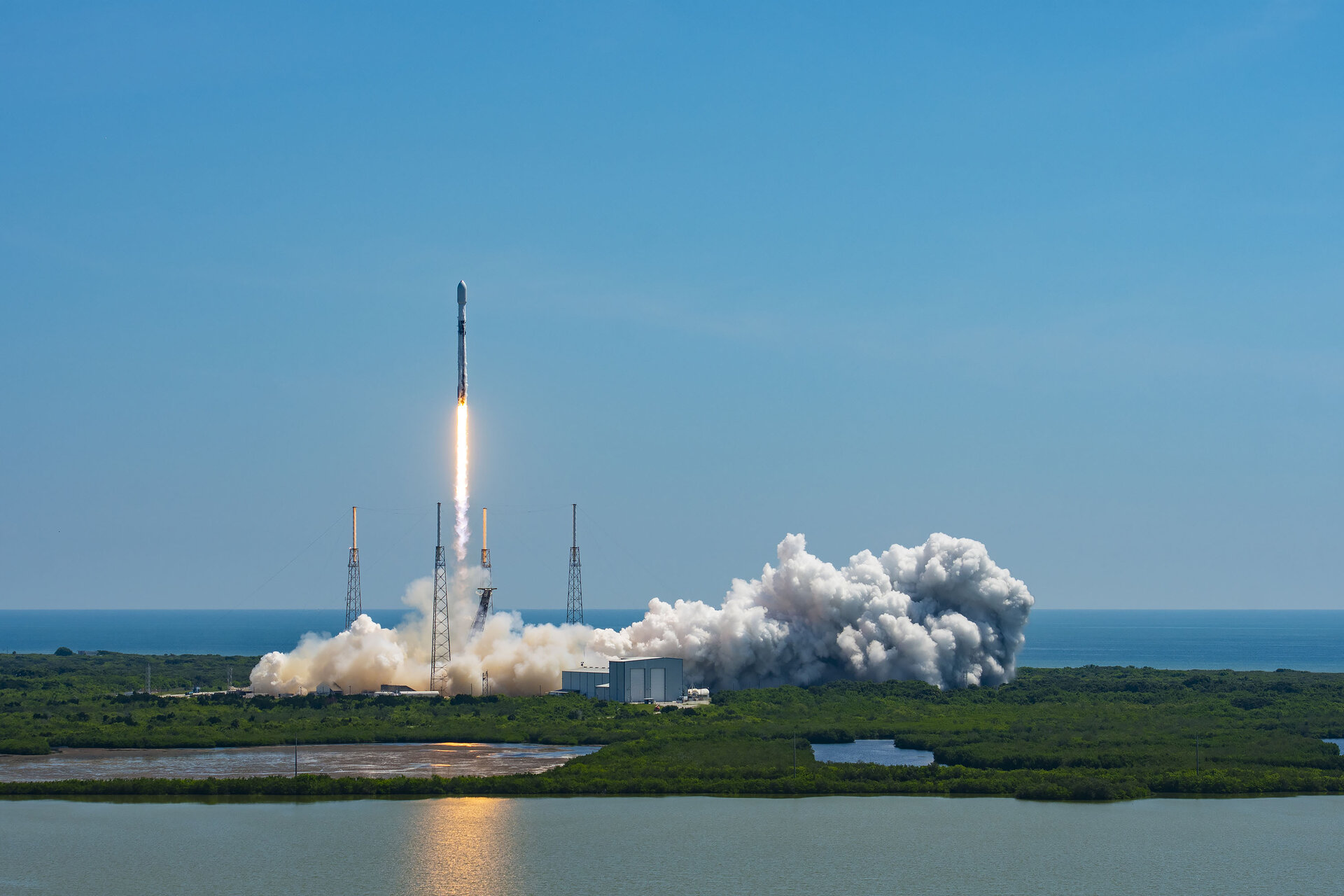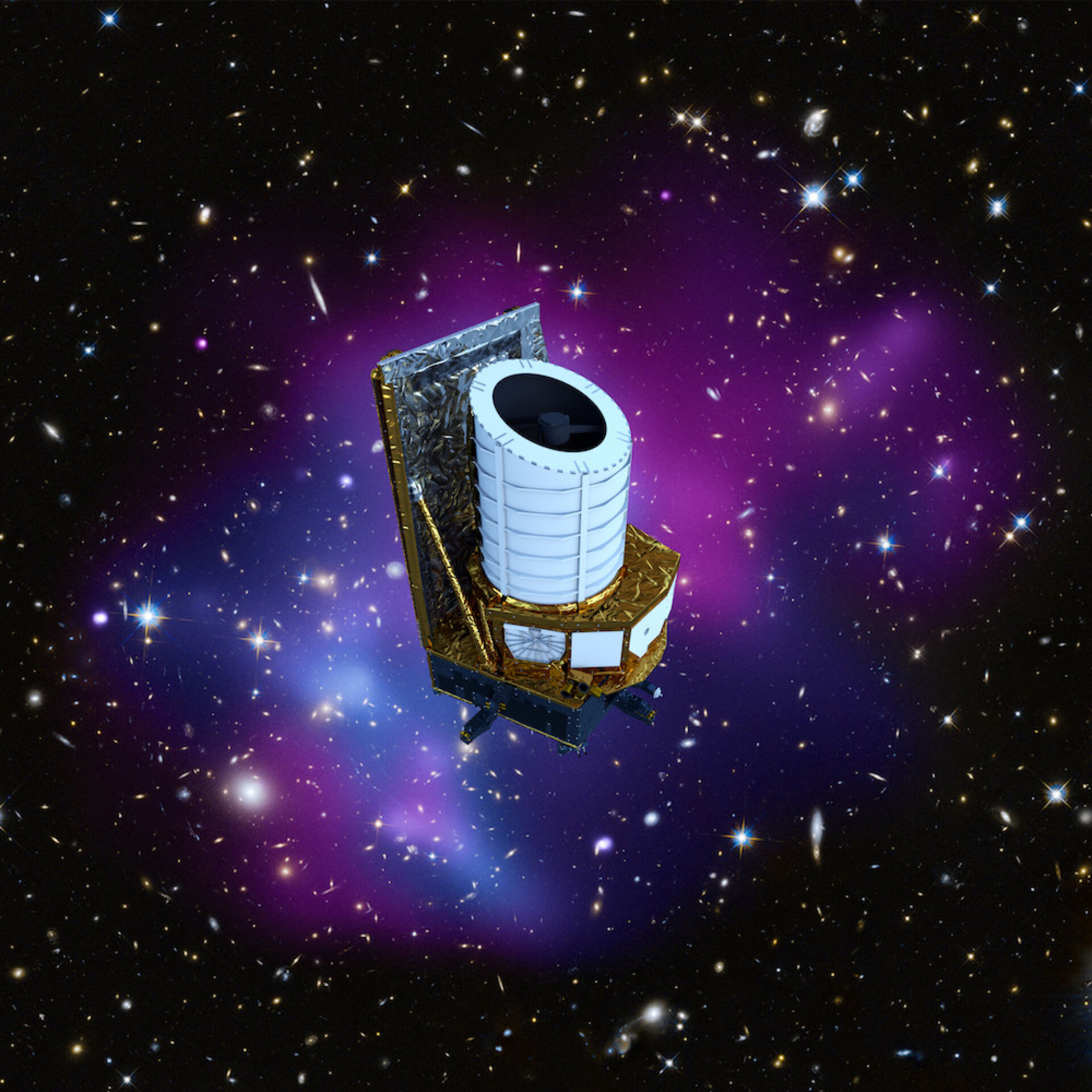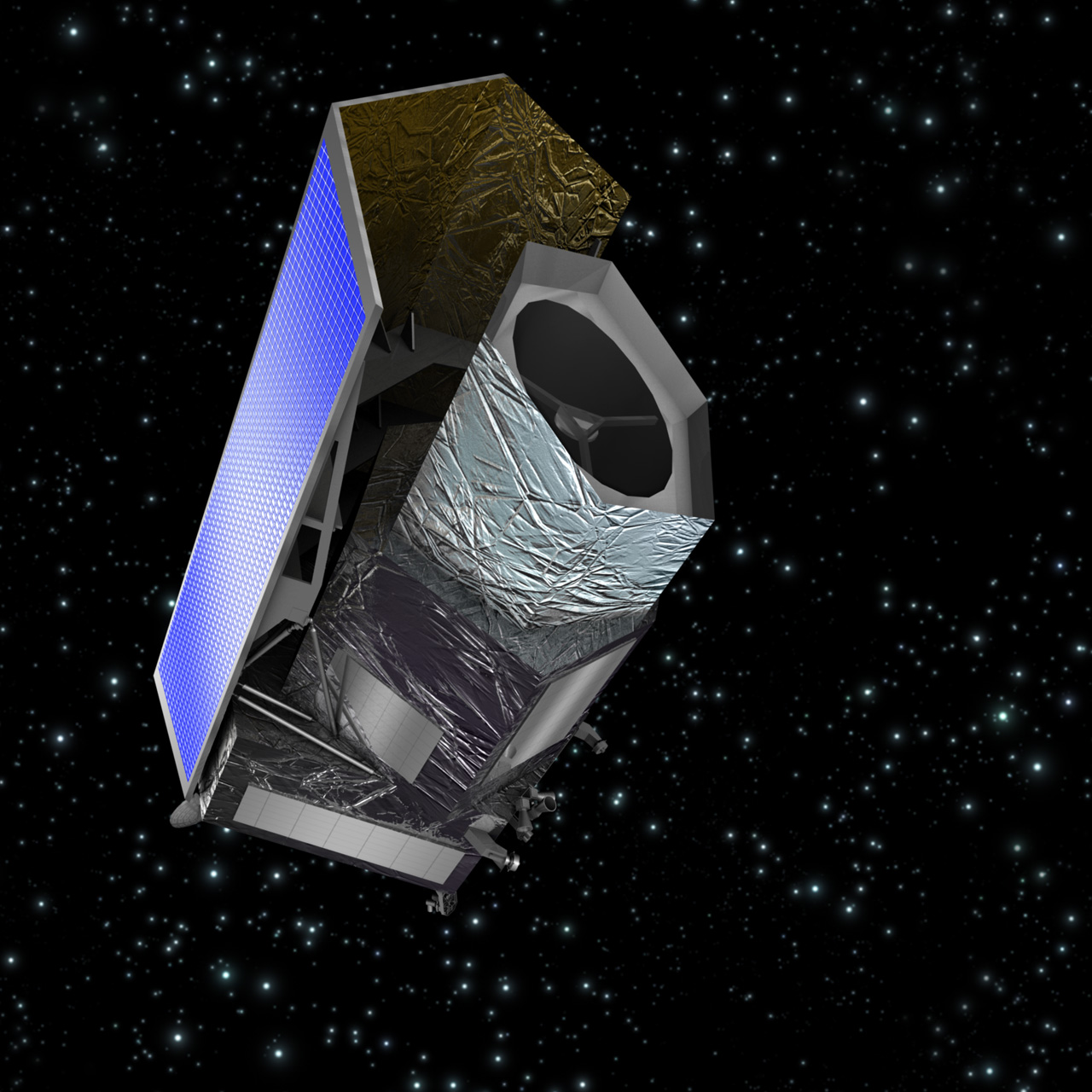The European Space Agency’s (ESA) Euclid Mission was launched on Saturday, 1st July 2023, and will explore the dark universe and capture billions of galaxies to create a 3D cosmic map. This will help space researchers to study the nature of dark energy and dark matter, and find out the reason behind the expansion of the universe.
What is Euclid?
Euclid is a spacecraft which is approximately 3.7 metres in diameter and 4.7 metres tall. It comprises two main components. These are the payload module and the service module.

Image Credits: ESA
The service module consists of satellite systems: data processing electronics, electric power generation and distribution, attitude control, telecommand and telemetry, thermal control and propulsion. The payload module contains a 1.2 metres diameter telescope and other two technical instruments, VIS (visible instrument) which is a visible-wavelength camera and NISP (near-infrared spectrometer and photometer) which is a near-infrared camera.
History of Euclid
Euclid is a combined mission of two other missions that were initiated in response to the ESA Cosmic Vision 2015-2025 Call for Proposals, March 2007. These proposals were Space, the Spectroscopic All Sky Cosmic Explorer, and Dune, the Dark Universe Explorer. Both these missions aim to investigate dark energy. Hence, after an assessment study phase, they together came as a single mission, Euclid. In October 2011, ESA’s Science Programme Committee selected Euclid for implementation and officially adopted it in June 2012.
The Euclid Mission
Euclid is a European mission built and operated by the ESA with significant contributions from NASA. ESA collaborated with Thales Alenia Space (an aerospace company) for the construction of the Service Module and satellite and Airbus Defence and Space (aeronautics corporation) for the development of the Payload Module and the telescope. NASA provided near-infrared cameras of the NISP instrument.
The mission got its name after the Greek Mathematician, Euclid of Alexandria who was the founder of geometry. As the densities of dark matter and dark energy are related to geometry, the mission was named in his honour.
On 1st July 2023, at 11:12 am ET, ESA successfully launched the Euclid spacecraft with the help of SpaceX Falcon 9 from Cape Canaveral Space Force Station, Florida, USA. It will take two months to reach its operational orbit, Sun-Earth Lagrange point 2 (L2), at an average distance of 1.5 million kilometres beyond the Earth’s orbit. After reaching the nearby orbit, it sent a signal to the mission control centre at 11:57 am ET. The mission will last for the next six years with the possibility of an extension.

Image Credits: ESA
Objectives of Euclid’s Mission
The main objective of this cosmological survey mission is to solve the mystery of the dark universe by focusing on dark energy and dark matter. The universe comprises 85 per cent of dark matter that can’t be observed directly. This invisible glue of the cosmos does not reflect, absorb or emit light. On the other hand, dark energy is an unknown force that is creating separation between the galaxies resulting in the expansion of the universe at an accelerated rate.
Space researchers plan to use the Euclid telescope to create 3D maps of the universe to know more about its history and structure. “Euclid is coming at a really interesting time in the history of cosmology,” said Jason Rhodes, a physicist at NASA’s Jet Propulsion Laboratory, Southern California, who leads Euclid’s U.S. science team. “We are entering a time when Euclid is going to be great at answering questions that are just now emerging. And I am certain that Euclid is going to be fantastic for answering questions we haven’t even thought of.”
Besides the 3D map, the research team will use a technique called weak gravitational lensing which is a light-bending phenomenon resulting in magnified, stretched or distorted images of galaxies. This technique will reveal how dark matter is distributed and how it bends the light from galaxies behind it.
Regarding the nature of dark energy, with the help of Euclid, the researchers hope to test if Albert Einstein’s theory of general relativity works differently on cosmological scales. They want to know whether dark energy is a constant force or a dynamic force whose properties change with time. “If we find out this is not a constant, but something that changes in time, then it would be revolutionary,” said Xavier Dupac, an ESA cosmologist on the Euclid mission. This discovery will show how dark energy has influenced the universe’s expansion.

Image Credits: ESA
Euclid will be in the universe along with Hubble and James Webb Space Telescopes. Unlike these two telescopes covering only one part of the sky at a time, researchers will use Euclid spacecraft to cover a wide area of the extragalactic sky simultaneously. Its visible and near-infrared cameras will record 1.5 billion galaxies in non-visible wavelengths and measure their redshift. Redshift is a phenomenon in which the wavelength of light is stretched and shifted towards the red part of the spectrum. This is used to determine how far the universe is and how it is expanding. Euclid will provide all the data about star formation rates, masses and shapes of the universe. This data will also help to discover new objects in the Milky Way Galaxy. The data will be publicly released in 2025, 2027 and 2030.
“Beyond its main science goals, Euclid will create a unique sky survey of 12 billion galaxies with an image quality rivalling that of the Hubble. It will be a gold mine for all fields of astronomy for several decades,” said Yannick Mellier, an astronomer at the Institut d’Astrophysique de Paris.
By May 2027, NASA’s Nancy Grace Roman Space Telescope will join Euclid to explore the dark universe. This joint mission will provide deep insights into the mysteries of dark and dark matter, create 3D cosmological maps and furnish astronomers with more precise measurements.
“Twenty-five years after its discovery, the universe’s accelerated expansion remains one of the most pressing mysteries in astrophysics,” said Rhodes. “With these upcoming telescopes, we will measure dark energy in different ways and with far more precision than previously achievable, opening up a new era of exploration into this mystery.”
To watch the Euclid Mission launch, click here.
If you enjoyed reading our articles, please consider supporting us by buying our geeky merchandise on Instagram.



3 comments
I do trust all the ideas you’ve presented in your post. They are really convincing and will definitely work. Nonetheless, the posts are too short for newbies. May just you please lengthen them a bit from next time? Thank you for the post.
[…] of the Indian Space Research Organisation (ISRO) is aimed to observe the Sun. Aditya-L1 will be at Lagrange point L1, which is about 1.5 million kilometres away from […]
[…] can be an enjoyable recreation. These shows portray the marvels of our universe, from revealing space mysteries to exploring significant scientific discoveries. In this article, we will discuss some captivating […]